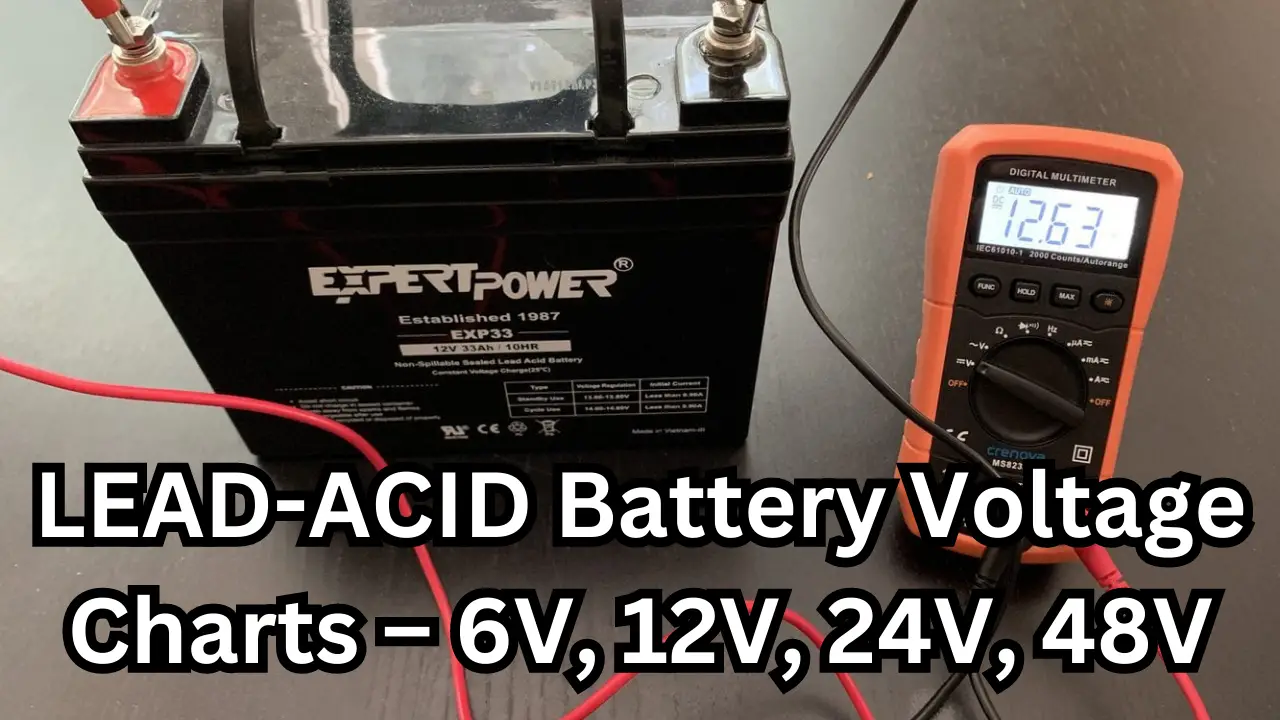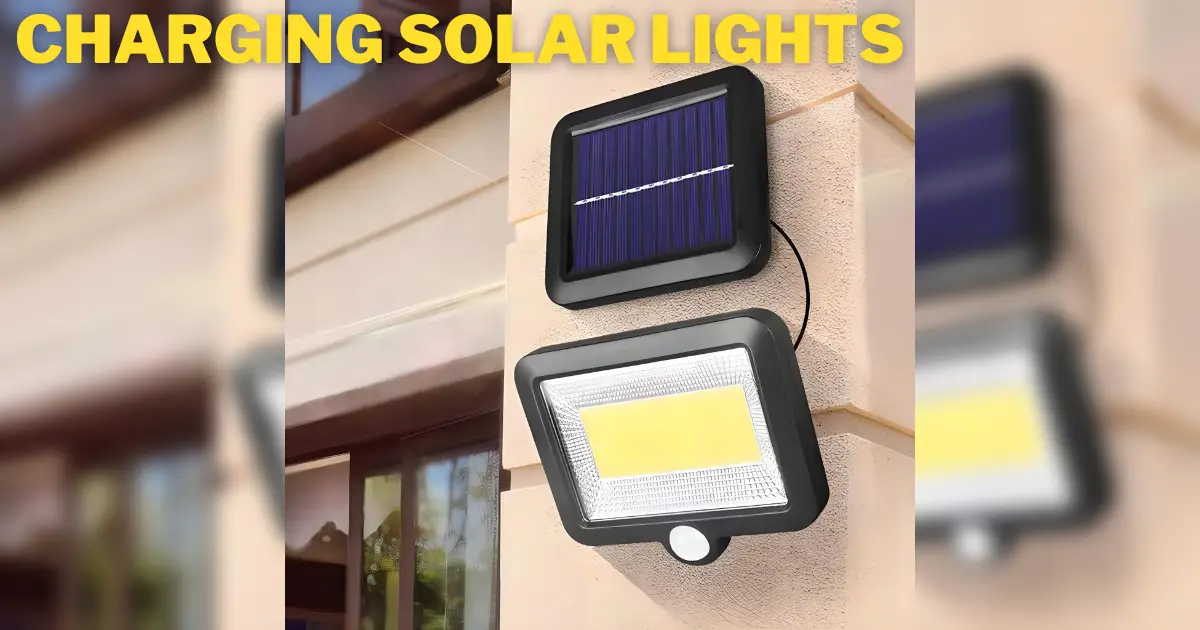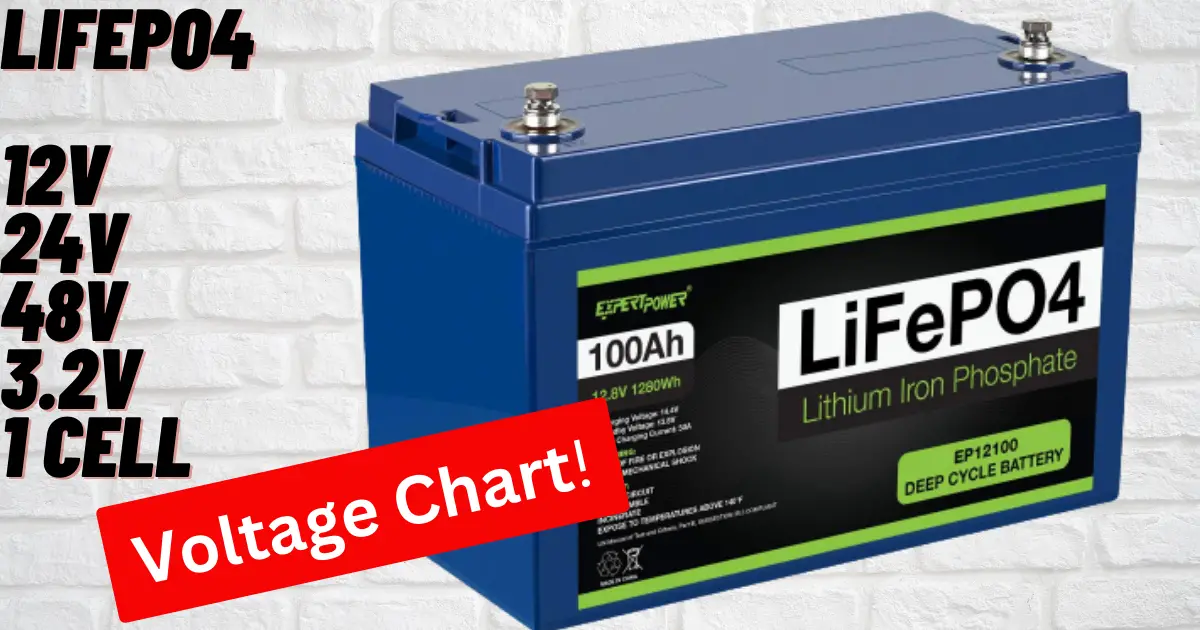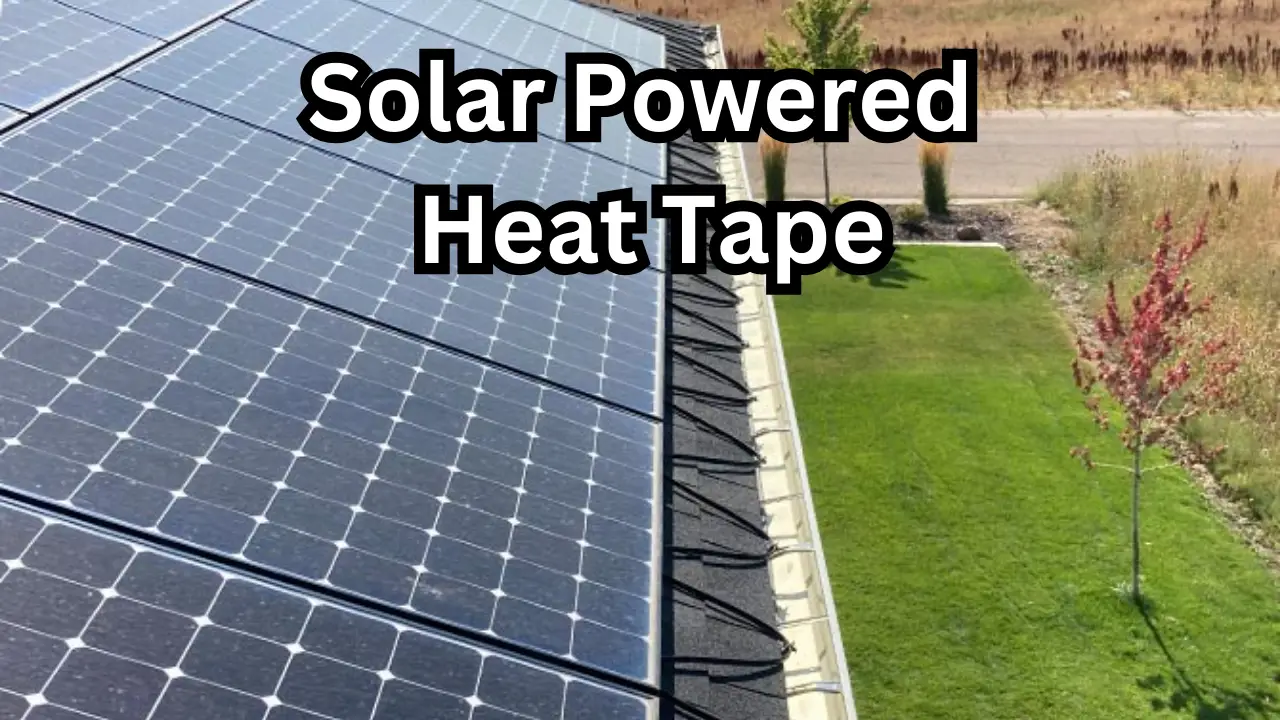Lead acid batteries, like all other types of batteries, have a varied voltage at various stages of charge. A 12V sealed lead acid battery, for instance, has a 12.89V at 100% charge, and when it drops to 11.63V, it is said to be at 0% charge.
The good news is that lead acid battery state of charge (SOC) charts are available if you need to determine the precise battery voltage (6V, 12V, 24V, 48V, etc.). By comparing the voltage of a lead acid battery to the appropriate percentage charge shown on this chart, you may determine how much more juice is still in the battery.
The voltage curves of lead acid batteries vary based on the battery type, temperature, and discharge rate, among other things. It is always advisable to refer to the lead acid battery voltage chart included in the handbook that comes along with the battery you are using/going to use, even though there are voltage charts that are readily available that you can locate online or acquire at your local battery store.
Types of Batteries
Speaking of battery types, there are two different kinds of lead-acid batteries:
- Sealed lead-acid (SLA)/valve-regulated lead acid (VRLA) batteries
- Flooded/wet lead-acid batteries.
Flood lead acid batteries are less expensive, but they also need more upkeep and ventilation. However, compared to flooded batteries, sealed lead acid (SLA/VRLA) batteries require less upkeep and ventilation. They are also leak-proof and can resist changing climates better.
Common uses for lead-acid batteries include backup power sources like uninterruptible power supplies (UPS), renewable energy systems like solar power systems, and, of course, automobiles (for starting and igniting power).

The most popular lead acid battery voltages, 6V, 12V, 24V, and 48V, are shown in the four lead battery voltage tables below. To reiterate, it is always preferable to use the chart that was included in your lead battery’s original packaging, but if you’re seeking a general overview, you can glance at the chart we’ve provided below.
Note – In addition, there are two critical points you should be aware of before moving forward:
- One, the battery should be at room temperature and at rest for at least 30 minutes before evaluating the state of charge.
- Second, the depth of discharge (DOD) of lead batteries is roughly 50%. This indicates that only roughly 50% of a lead acid battery’s total capacity may be drained and used.
Battery SoC Chart
The capacity that is currently available is referred to as the state of charge (SoC). The value of the state of charge is between 0% and 100%. A battery’s state of charge is 100% when it is fully charged, whereas 0% indicates that the cell is entirely discharged.
Once the state of charge reaches that point, the cell is refilled since, in real-world applications; the value cannot rise above 50%.
6V Lead Acid Battery Voltage Charts
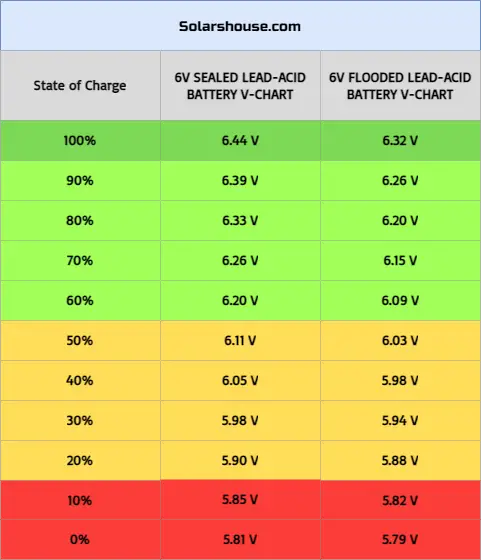
Some DC devices, including lights, pumps, and electric motorcycles, use 6V lead-acid batteries. A 12V battery bank can also be made by wiring two together in series. Three 2V lead acid cells are connected in series to create them.
Assuming a maximum depth of discharge of 50%, 6V sealed lead acid batteries reach full charge at roughly 6.44 volts and reach full discharge at about 6.11 volts.
Assuming a maximum depth of discharge of 50%, 6V flooded lead acid batteries reach full charge at roughly 6.32 volts and reach full discharge at about 6.03 volts.
12V Lead Acid Battery Voltage Charts
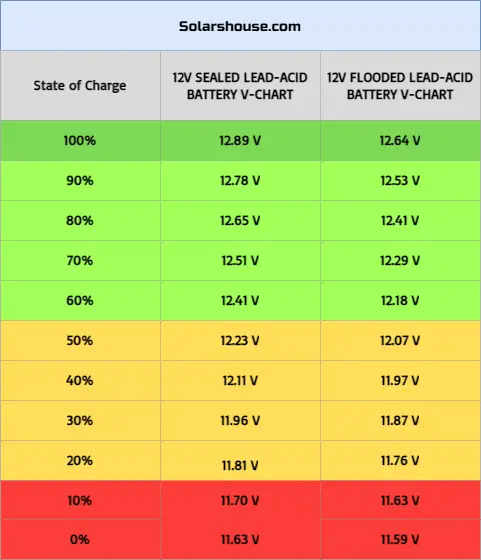
Rechargeable solar power systems like Nature’s Generator Elite Gold System and Nature’s Generator Gold System frequently employ 12V lead acid batteries. The 12V AGM-sealed lead acid batteries used in these portable solar generators are each equipped with a front LCD display that indicates the battery level so you can determine when a recharge is necessary.
Returning to the graph above, it can be seen that, assuming a maximum DOD of 50%, a 12V sealed lead acid battery is fully charged at 12.89 volts and totally drained at 12.23 volts. This demonstrates a 0.66-volt difference between a charge of 100% and 0%.
On the other hand, a 12V flooded lead acid battery is fully charged at 12.64 volts and totally drained at 12.07 volts (assuming 50% maximum DOD). As you can see, the difference in charge between 100% and 0% is 0.57.
24V Lead Acid Battery Voltage Charts
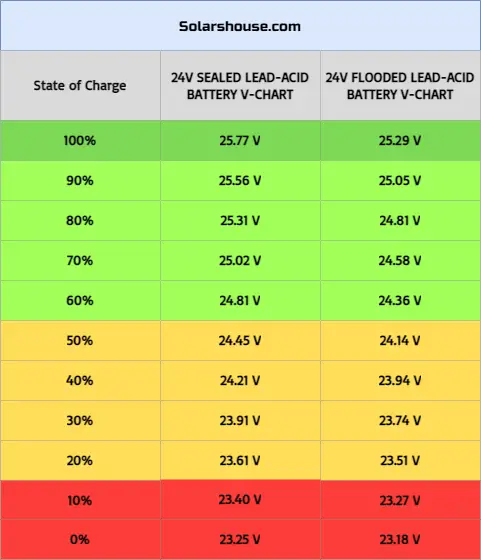
Another popular battery choice for solar power systems, especially those that offer higher power capacities, is a 24V lead acid battery.
Assuming a maximum DOD of 50%, a 24V sealed lead acid battery is fully charged at 25.77 volts and totally drained at 24.45 volts. The difference between a 100% charge and a 0% charge is a full 1.32 volts.
Between 100% and 0% charge, there is a whole 1.15-volt difference. On the other hand, a 24V flooded lead acid battery is fully charged at 25.29 volts and totally drained at 24.14 volts (assuming a maximum DOD of 50%).
48V Lead Acid Battery Voltage Charts
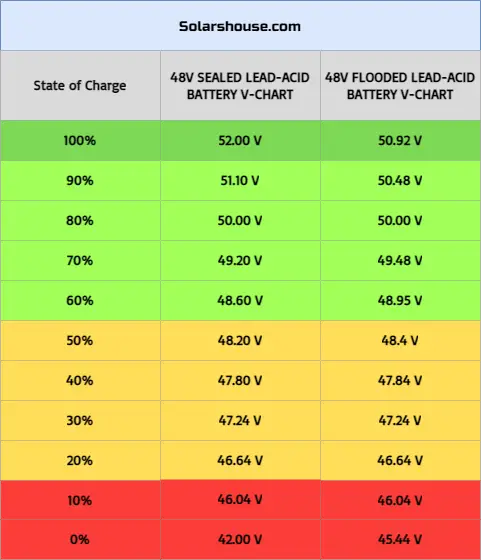
A 48V lead acid battery is typically utilized by telecom firms as a backup power source. Additionally, it is employed in high-power solar generators like Nature’s Generator Powerhouse.
According to the aforementioned chart, a 48V sealed lead acid battery is fully charged at 52.00 volts and fully drained at 48.20 volts (assuming a maximum DOD of 50%). This results in a 3.80-volt differential between a charge of 100% and 0%.
A 48V flooded lead acid battery, assuming a maximum DOD of 50%, is fully charged at 50.92 volts and fully drained at 48.40 volts. This then demonstrates a 2.52-volt difference between a discharge of 100% and 0%.
How to Test the Capacity of a Lead Acid Battery
You can determine the capacity of a lead acid battery in a few different methods.
- Use a Multimeter – Compared to other types of battery capacity testers, a multimeter can deliver the most accurate and dependable readings, making it the best and simplest way to test a battery’s charge.
- Get a hydrometer to measure specific gravity – Due to its accuracy, using a hydrometer to measure lead acid battery capacity is another excellent option. This only has one drawback—it can only be used with flooded/wet lead acid batteries.
- Using a Solar Charge Controller – If you currently have or are going to purchase a solar power system, it probably already comes with a battery status indicator. However, if you don’t, you may still purchase a solar charge controller. This method is still a decent way to get an estimated result for your guidance, even though it is less exact than a multimeter or a hydrometer. Please read the manual’s section on the margin of error.

FAQs
What is the lead acid battery’s 12V minimum operating voltage?
A 12V sealed lead acid battery’s lowest open circuit voltage is around 12.2 volts, assuming a maximum depth of drain of 50%. A 12V flooded lead acid battery’s minimum open circuit voltage, assuming a 50% maximum depth of drain, is around 12.1 volts.
What is a 12V lead acid battery’s float voltage?
A sealed 12V lead acid battery typically has a float voltage of 13.6 volts plus or minus 0.2 volts. A flooded 12V lead acid battery typically has a float voltage of 13.5 volts.
Follow the suggested float voltage described in your battery’s handbook, as always. Some companies call float “standby.” On occasion, your battery’s label will even include the float voltage.
Final Thoughts
If someone wants to get the most out of their batteries, they must comprehend and use a lead acid battery voltage chart, which is an essential resource. For people who are not professionals but need advice on how to correctly manage their lead acid batteries, this specific chart is a valuable resource.
Just keep in mind that while using generic lead acid battery voltage charts is perfectly acceptable, using the chart provided by the battery’s (or the product’s) manufacturer will provide the greatest and most accurate information regarding the battery’s level of charge.

